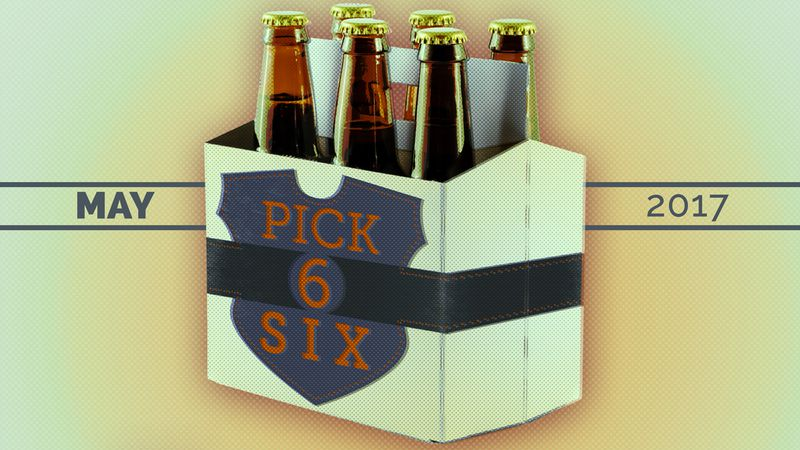6 Beers You Should Drink This Month
Pick Six is The A.V. Club's monthly recommendations for the beers we're currently digging.
The first of May is celebrated for a variety of official, codified reasons. The oldest of these celebrations, May Day, is a festive, pagan way to mark the coming of summer. Then there's International Workers' Day, celebrated around the world on the anniversary of the Haymarket Riot. On the other hand, American lawmakers have also deemed May 1 Loyalty Day, as well as Law Day. Both are still on the books. So whether you're for magic, workers' rights, or conformity, you have a reason to celebrate today. Personally, I'll be celebrating "102 Days Without Going To War Day." I just made that one up, but it definitely is celebrated by drinking a beer. In fact, here are six beers you should drink this month no matter what holiday you're observing.

1. Rodenbach Classic is a refreshing, slightly tart, fruity beer from Belgium. It's made by blending three parts fresh beer with one part aged beer. The aged beer sits in one of 300 giant oak foeders (wooden fermentation tanks) for up to two years before blending. That's the same as one term in the U.S. House of Representatives. I can't speak for the politicians, but the beer gets extremely acidic and sour through this process. After blending, that aspect is tempered, and the depth of flavor reveals one of the most enjoyable, interesting, and yet accessible drinks in all of beerdom. They've been churning out this beer since 1820, and I suspect that somewhere along the way some pagan magic rubbed off on those wooden vats.

2. Parish Brewing Envie APA was a happy surprise on a recent visit to New Orleans. In a town that has poured exponentially more effort into cocktails (and frozen daiquiris) than beer, I never once heard this beer described as a New England IPA. Yet all the hallmarks are there—haze for days, juicy hops, and no bitterness. While I do not buy into the obsessive "camp outside a brewery on release day" hype around NEIPAs, when you can find one without that baggage, it's a pleasant drink.

3. Solemn Oath Brewery Snaggletooth Bandana IPA is like the opposite of a NEIPA. Instead of rounding off the corners, this suburban Chicago beer throws its bitterness around like a punk throwing elbows in a mosh pit. The label art features leather-clad, mohawked punks and a mix of Old English font and handwriting. It's easy to imagine this beer fueling an anticapitalist zine-making party in 1983 (though of course, most folks drank terrible beer back then, and this brewery did not exist).

4. Schlafly Coconut Crème Ale is a special release from the St. Louis brewery that won a trademark on the Schlafly name last year. Brewery founder Tom Schlafly successfully fought off legal protests from his famous aunt, conservative activist Phyllis Schlafly, just one month before she died last year. Back in the 1970s Phyllis led the charge that successfully thwarted the Equal Rights Amendment from ensuring women's rights were protected by the Constitution. While the brewery is not especially politically active by craft beer standards (and was sold to a private equity group in 2012), knowing this brewery dealt Phyllis Schlafly at least a small defeat may make this balanced blond dessert beer, made with wheat and fresh and toasted coconut, taste a little bit sweeter to feminists.

5. Half Acre Beer Co. Vallejo IPA is probably the most beautifully packaged beer I've ever purchased. Fortunately the beer inside the can is just as artfully made: A "hop crasher" sold April through August that coaxes out pineapple flavors from aroma to finish. This Chicago brewery made its name selling tallboy cans of its original IPA, Daisy Cutter. Now featuring three regular IPAs and three more regular IPA-adjacent styles, Half Acre celebrates 10 years in the business this summer.

6. Leinenkugel's 150th Anniversary Lager is a beer I probably wouldn't have tried if the brewery hadn't sent it to me. A family brewery established in 1867 in Chippewa Falls, Wisconsin, Leinenkugel was bought by Miller Brewing Company in 1988, the same year Goose Island, the current poster child of craft beer sellouts, opened its first brewpub. After one too many bad experiences with its Berry Weiss and Summer Shandy, I'd avoided Leine's. But this lager, brewed in collaboration with Hofbräu München is a delightful decoction from start to finish. I could see workers around the world enjoying this beer alongside chargrilled sausages whether today was International Workers' Day or not.
If you have a brew you'd like considered for Pick Six, send us an email at avclubbeer@gmail.com.
